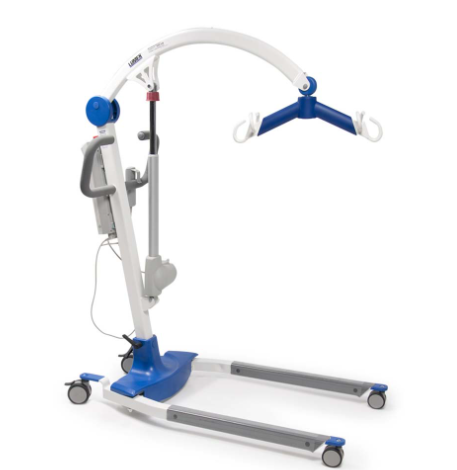Electric Hoyer lift

An electric Hoyer lift is a medical device that uses battery power to safely and easily transfer a person with limited mobility, such as those with paralysis or severe arthritis, from one surface to another, like a bed to a wheelchair. Operated via a remote control, it employs a padded sling placed around the individual and connected to the lift's frame to raise and lower them. These lifts reduce strain on caregivers, offer features like folding frames for portability and integrated scales for weighing, and are used in home care and clinical settings.
How it works
Sling placement: A caregiver places a specialized sling under the patient's body.
Connection to the lift: The sling's straps are attached to the lift's "boom" or arm.
Operation: The caregiver uses a battery-powered remote control to raise the patient.
Transfer: The lift moves the patient to their desired location, such as from a bed to a wheelchair or commode.
Lowering: The caregiver then uses the remote to gently lower the patient into the new position.
Key Features and Benefits
User-friendly controls:
A remote or button panel allows for easy operation of the lift's powered functions.
Reduced caregiver strain:
Powered lifting minimizes the physical effort and back strain for caregivers during transfers.
Portability:
Many models, like the Hoyer Advance E, have folding frames for easy storage and transport.
Safety features:
Some lifts include emergency stop buttons, power-assisted leg opening for maneuverability, and digital displays for weight.
Versatility:
They are designed for various transfer types, including from bed to wheelchair, chair to commode, or even from a floor to a bed.
Increased patient comfort and stability:
Features like the "Swan neck" leg design allow the lift to get closer to the patient and furniture.
Optional add-ons:
Some models can be equipped with digital scales for weighing patients, which is useful for those with limited mobility.
Who uses it
electric Hoyer lifts are a valuable tool for both professional caregivers and family members. They are used in hospitals, nursing homes, and private residences to assist individuals with conditions such as: Paralysis, Spinal cord injuries, Severe arthritis, and Mobility impairments.